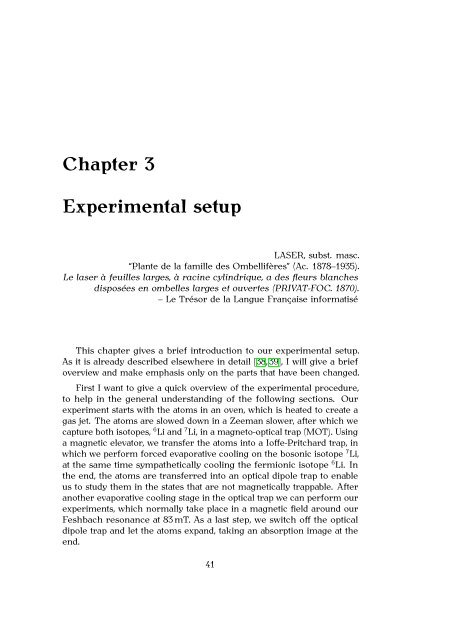Martin Teichmann Atomes de lithium-6 ultra froids dans la ... - TEL
Martin Teichmann Atomes de lithium-6 ultra froids dans la ... - TEL
Martin Teichmann Atomes de lithium-6 ultra froids dans la ... - TEL
You also want an ePaper? Increase the reach of your titles
YUMPU automatically turns print PDFs into web optimized ePapers that Google loves.
Chapter 3<br />
Experimental setup<br />
LASER, subst. masc.<br />
“P<strong>la</strong>nte <strong>de</strong> <strong>la</strong> famille <strong>de</strong>s Ombellifères” (Ac. 1878–1935).<br />
Le <strong>la</strong>ser à feuilles <strong>la</strong>rges, à racine cylindrique, a <strong>de</strong>s fleurs b<strong>la</strong>nches<br />
disposées en ombelles <strong>la</strong>rges et ouvertes (PRIVAT-FOC. 1870).<br />
– Le Trésor <strong>de</strong> <strong>la</strong> Langue Française informatisé<br />
This chapter gives a brief introduction to our experimental setup.<br />
As it is already <strong>de</strong>scribed elsewhere in <strong>de</strong>tail [38, 39], I will give a brief<br />
overview and make emphasis only on the parts that have been changed.<br />
First I want to give a quick overview of the experimental procedure,<br />
to help in the general un<strong>de</strong>rstanding of the following sections. Our<br />
experiment starts with the atoms in an oven, which is heated to create a<br />
gas jet. The atoms are slowed down in a Zeeman slower, after which we<br />
capture both isotopes, 6 Li and 7 Li, in a magneto-optical trap (MOT). Using<br />
a magnetic elevator, we transfer the atoms into a Ioffe-Pritchard trap, in<br />
which we perform forced evaporative cooling on the bosonic isotope 7 Li,<br />
at the same time sympathetically cooling the fermionic isotope 6 Li. In<br />
the end, the atoms are transferred into an optical dipole trap to enable<br />
us to study them in the states that are not magnetically trappable. After<br />
another evaporative cooling stage in the optical trap we can perform our<br />
experiments, which normally take p<strong>la</strong>ce in a magnetic field around our<br />
Feshbach resonance at 83 mT. As a <strong>la</strong>st step, we switch off the optical<br />
dipole trap and let the atoms expand, taking an absorption image at the<br />
end.<br />
41

















